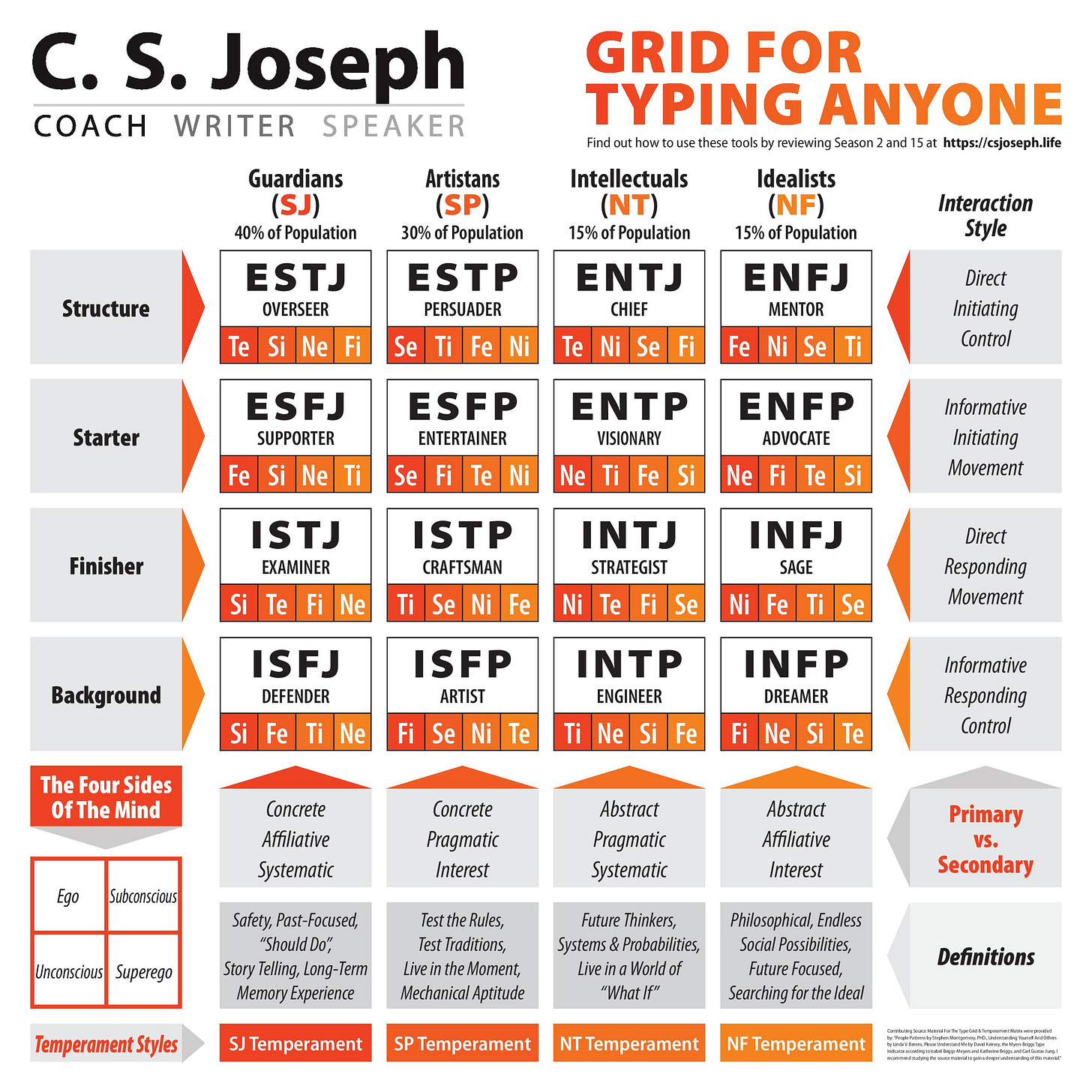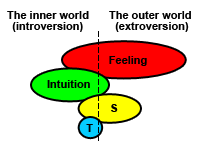Jungian archetypes disclose the contours of adaptive hill climbing and valley crossing
The cognitive function stack as dualistic evolutionary strategies enmeshed in uniquely ordered combinations.
My friend Scott is an expert at Jungian typology. Many people are familiar with Myers-Briggs framework for personality typing that was created based on Jung’s work. You’ve probably taken one of the MBTI personality tests at some point in your life and read about the 16 different personalities in this scheme. As with most (personality) models, I am both curious and skeptical – and the latter especially when certain claims of predictive power are made.
Jungian Archetypes
After spending time with Scott, I’ve learned that this typological approach was further extended by an array of psychologists in the later 20th century. In particular, the work of David Keirsey adds a richness to personality typing by coagulating it with an analysis of temperament and interaction styles. The inclusion of many different facets beyond personality pushes the art into something that becomes more dynamic and prescriptive rather than just observational or explanatory.
Scott has trained me a fair amount in this extended Jungian “archetype” model, and I have to say: I find it much more reifying than the original MBTI “personality” framework I was introduced to years ago. C.S. Joseph, a present-day Youtube personality and life coach, has produces a a litany of content based on Dr. Keirsey’s work that makes it accessible to laymen like me.
The model referenced here is complex so I don’t plan on going into deep details; if you want to know the nitty-gritty before proceeding, watch some videos or read articles (if you want to be trained in this art, contact me and I’ll put you in touch!).
I want to focus on the cognitive function stack. More specifically, I will share with you how my understanding of cognitive function stack has unfolded. I tend to understand most abstractions through the frames of multiscale complexity and evolutionary processes. My understanding of the cognitive functions is no different, and therefore, it’s not surprising that I’m able to see them as yet another evolutionary pattern.
Cognitive Functions
As you can see from the typing chart, the cognitive functions arrange themselves into a unique stack in each archetype. While interaction styles – and to a lesser degree, temperament – are used to type someone, the function stack describes distinct approaches to gathering information, generating conclusions, producing action, experiencing emotion, etc. In other words, function stack points to a conglomerate of ordered strategies moulded and together that ultimately produce the hallmarks of each archetype.
Two different axes produce the eight unique cognitive functions:
Prospecting or Judging [N,S,F,T] × Introversion or Extraversion [i,e]
= Ni, Ne, Si, Se, Fi, Fe, Ti, Te
Furthermore, each of these function has a unique “characteristic”, or adjective, to identify it and its role in an archetype.
The introverted functions point out a predilection to generate internal mappings and project them outward. On the other hand, the extraverted functions point out a predilection to ingest external mappings and metabolize them inward.
With this in mind, let’s discuss molecular evolution.
Molecular Evolution
Within molecular evolution, fitness landscapes are often described in the language of a physical territory. That is to say, an evolutionary landscape consists of various peaks and troughs across a combinatorial ecology. Fitness is measured by how well organisms, species, or alleles are able to steadily climb up mountains and establish stability into niche that they adapt to. In this sense, mutations that don’t allow for a steeper gradient ascent on the inhabited mountain are considered less fit.
Importantly, however, mutations that arise appearing deleterious (by inhibiting fitness in this first sense) can often become extremely adaptive: by pushing an individual/group/gene out of the existing gradient, across to a different niche, a new adaptive peak is discovered which makes previously unfit adaptations now the superior strategy for gradient ascent.
These dualistic approaches to evolutionary fitness are sometimes colloquialized as “hill climbing” and “valley crossing”. Often, a single organism or species will tend to specialize in one or the other.
What’s interesting about humans, and what makes them evolutionary superior, is that they are able to execute both strategies with high reproductive success. That is to say, people make for excellent nomads, by constantly moving from one context to another, creating novel ways to thrive in a state of permanent chaos; they also make for excellent settlers, picking out specific settings and civilizing their surroundings into a maintained order.
Weaving Together
Becoming a good hill climber relies on the ability to create high-fidelity maps of the dynamic environment one already inhabits to sharpen powerful instincts that can be shared with others as models for success.
Becoming a good valley crosser relies on the ability to explore vast and unknown environments and effectively stake out which novel niches might be hospitable by epitomizing the new dynamics.
Do you already see where I’m going with this?
Both of these evolutionary strategies are generalized descriptions, and are expressed in particular contexts. For example, consider the human adaptation of tool usage: a hill climber excels as taking existing tools and refining them to become more effective as per their original use, i.e., more efficient, less energy-intensive, more locomotive; a valley crosser excels at using existing tools in unheard of ways or combining them to make new tools addressing emergent problems.
I propose that introverted cognitive functions correspond with hill climbing and extraverted cognitive functions correspond to valley crossing.
This connection is made more clear when one considers the typical failure modes of each approach. Introverted functors, just like hill climbers, struggle when asked to jump between many different configurations and extract salience from each one. Extraverted functors, just like valley crossers, struggle when required to commit to a particular configuration and hone their incremental progress.
Remember, from what I stated above, that humans employ both of these dualistic fitness strategies with aplomb. Thus, one recognizes that the Jungian archetypes and their revealed function stacks point to the exact areas in which a given individual prefers to employ one strategy (or, perhaps more accurate, perform one role) over another.
Because I’m a visual leaner, in my own personal study, I’ve started substituting the evolutionary terminology for these dual conceptions of “introverted/hill climbing” and with “seafaring” and “palace building”, respectively.
Strategic Stacks
According to the Jungian framework, opposing cognitive functions always occur in pairs in a given archetype. This indicates that the cognitive functions are a form of adaptive tradeoff, which is consistent with how fitness adaptations materialize on the molecular level. An allele that confers an advantage in X,Y,Z will often create a disadvantage in U,V,W, and vice-versa.
Opposing Function Pairs
Prospecting: Ne/Si, Ni/Se
Judging: Fe/Ti, Ti/Fe
The ordering of the stack provides insight into the hierarchy that the adaptations submit to, which gives rise to a fascinating ordered complexity. One starts to notice the peculiar ways in which different individuals engage in seafaring versus palace-building. Beyond that, one can start to conceptualize axes on which these tradeoffs render.
If you take me (an ENFJ) as an example, you’ll observe that I am:
The Fe-Ni “dominant” axis: emotionally expressive/connected supported by a protective distillation of core wisdom/insight
The Fe-Se “optimistic” axis: an adventurous pirate when it comes to values/ethics and physical sensations.
The Ni-Ti “pessimistic” axis: a hard-nosed architect when it comes to symbolism/patterns and logic/data/causality.
and so on.
Further Synthesis
Perhaps this understanding of Jungian archetypes, using the frameworks of evolutionary processes and ordered complexity, as applied to the cognitive functions of the ego, can perhaps be further applied to analyzing the shadow, subconscious, and super-ego. I haven’t got there yet, though.







